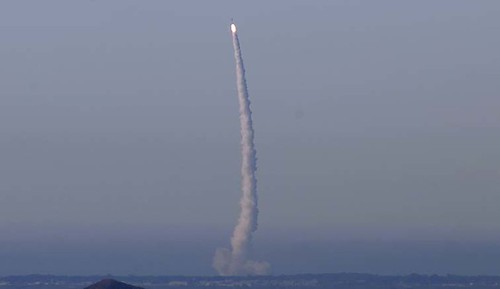Uncontrolled Re-entry by Spy Satellite
Apparently, a spy satellite is no longer in control and could crash to earth very soon. Today’s New York Times has some detail:
Specialists who follow spy satellite operations suspect it is an experimental imagery satellite built by Lockheed Martin and launched from Vandenberg Air Force Base in California in December 2006 aboard a Delta II rocket. Shortly after the satellite reached orbit, ground controllers lost the ability to control it and were never able to regain communication.
Of course, somebody has to think of the worst. This report from Canadian TV picks up on the hydrazine threat:
Gordon Johndroe, a spokesman for the U.S. National Security Council, said appropriate government agencies are monitoring the situation.
"Numerous satellites over the years have come out of orbit and fallen harmlessly," he said. "We are looking at potential options to mitigate any possible damage this satellite may cause."
It’s unknown whether the U.S. may attempt to destroy the spy satellite before it re-enters the atmosphere.
"It’s not all that easy," said Atwood. "You’re not going to shoot it down, you’re just going to explode it into a million pieces that are ultimately going to fall on the Earth."
An anonymous government source told AP that the satellite contains a rocket fuel called hydrazine, which is a toxic chemical and can be harmful to anyone exposed to it.

One of the news "sources" cited a launch out of Vandenburgh AFB on a Delta II rocket. Probably the NROL-21, a classified NRO spacecraft. Judging from its orbit (353 km x 380 km, 58.5°), it’s probably an experimental radar, according to Gunther:
NROL 21 is the cover-name for one-off classified satellite. Although nothing is known about the mission, the orbit hints for an experimental radar reconnaisance satellite.
A few weeks after launch reports emerged, that grond stations were unable to communicate with an expensive experimental U.S. spy satellite launched last year by the U.S. National Reconnaissance Office (NRO). Efforts were said to be continuing to reestablish communication with the classified satellite, which cost hundreds of millions of dollars, but "the prognosis is not great at this point," said the defense official, who asked not to be identified.The official said the problems were substantial and involved multiple systems, adding that U.S. officials were working to reestablish contact with the satellite because of the importance of the new technology it was meant to test and demonstrate. An other source said the satellite had been described to him as "a comprehensive failure."
In August 2007 the satellite has been declared a complete loss and will be allowed to decay from orbit.
I doubt the re-entry will be as pretty as the launch was…

It certainly will not have an on-board camera like the launch did (fast forward to 2:35 — that’s when the action begins):
An amazing video. SM-3 missile intercept test.
I like the resource on losing weight. You did a great job. Bravo!